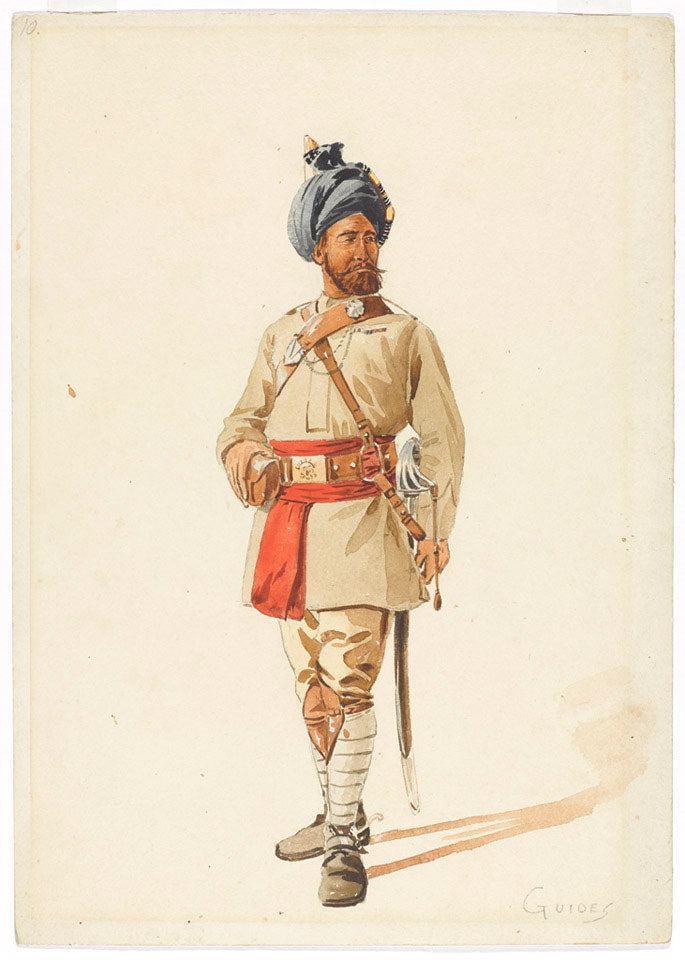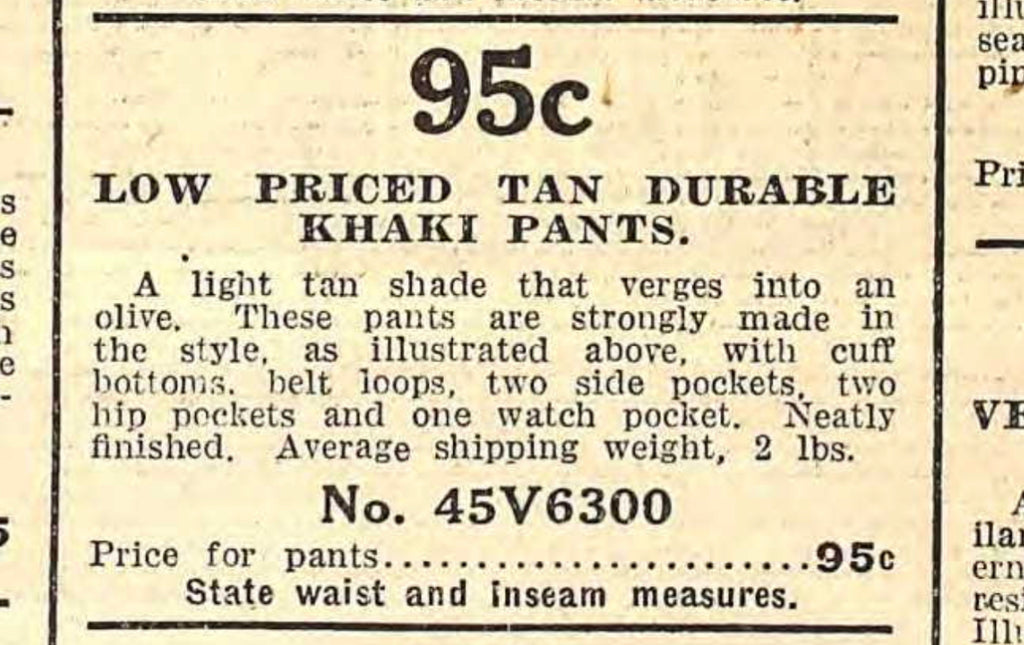
Foot race, Wyoming, 1935. The man in the center is wearing tan chinos. Image courtesy of Lora Webb Nichols Papers.
The denim/heritage world is naturally steeped in history as most of what we’re doing here is reproducing clothing from the past. But as anyone who’s studied history knows, history isn’t always historical. Sometimes what we’re dealing with are nothing more than myths that have been handed down to us as knowledge. Here’s one commonly held belief: chinos only became popular after World War II. The logic goes that since chinos were issued to officers, who wore them home from duty and after the war, that they first became ubiquitous and then a style statement. Sounds good, but is it true?

Chino pants in 1943, photos from my personal collection.
First of all let’s start with some hair-splitting with the ‘myth’ itself: historical articles often try to make a distinction between ‘chinos’ and ‘khakis’ but will then use them interchangeably in the same piece. The Wikipedia entry for khakis is a prime example of this and no doubt it serves as a historical resource for aspiring writers and interns at major style publications who’ve been tasked with turning around a 500-word article about the history of chinos by the end of the summer (I’ve been there).

Wrong.
Interestingly, the very same entry correctly cites the origin of chino cloth’s origins:
“Khaki was first worn as a uniform in the Corps of Guides that was raised in December 1846 by Henry Lawrence (1806–1857),[7] agent to the Governor-General for the North-West Frontier and stationed in Lahore.”

Jemadar, Queen's Own Corps of Guides (Cavalry), 1890. Watercolor drawing by Alfred Crowdy Lovett (1862-1919), 1890. Image courtesy of the National Army Museum (UK).
Another issue is that ‘khaki’ and ‘chino’ are vying for meaning, which only serves to confuse matters when it comes to its origin. 'Khaki’ is a dust-colored clothing, it being the Urdu word for ‘dusty’ from Persian ‘urd’, or dust, according to Etymonline. The name entered the English lexicon in 1846 when it was used by British cavalry in India to refer to their new tan-colored, lightweight uniforms. The term ‘chino’, which refers to a tan-colored twill fabric of cotton or linen comes into play five decades later. Here’s what the Wiki entry for chinos says:
“Developed in the mid-19th century for British and French military uniforms, it has since migrated into civilian wear. Trousers of such a fabric gained popularity in the U.S. when Spanish–American War veterans returned from the Philippines with their twill military trousers.
As the cloth itself was originally made in China, the trousers were known in Spanish as pantalones chinos (Chinese pants), which became shortened to simply "chinos" in English.”

Spanish soldiers in Cuba, 1898. Image courtesy of William K. Combs.


Pictured above, US Army soldiers of the 17th Infantry headed to the front during the Philippine-American War, 1899. Photo courtesy of the National Archives.
And there you have it, myth busted. I kid, sort of! I will slightly dispute one point above: the Spanish-American War ended in 1898 but to say that chinos gained in popularity immediately following the war is perhaps overstating things a bit. But it did set the ball in motion. How do I know that? One needs only to look at photographs and catalog listings from the time.

Above, a drilling crew poses for a photo on Spindletop Hill in Beaumont, Texas where the first Texas oil gusher was discovered January 10, 1901. Photo courtesy of the Texas Energy Museum/Newsmakers.
Khaki tan chino clothing seems to have found a home early on in oil fields though I’m not sure why. Perhaps many of the roughnecks were returning enlisted soldiers? More on that later, though.
Using Sears catalogs as a barometer though, what I found is khaki tan cloth was first mentioned in 1903 as a new fabric for football uniforms:

Here’s the 1904 Michigan Wolverines wearing tan shirts and pants:

In 1904 Sears began to introduce khaki tan twilled cloth for boys’ outfits, and in 1905 it introduced men’s suits in the fabric:

Khaki fabric was being marketed as Army cloth in the early 1900s; is it possible that this was Army surplus fabric?



Finally, a standalone pair of khaki tan pants here in 1910:

Here’s a Sears Spring/Summer 1915 listing for tan khaki twill fabric by the yard:

However in the same catalog, under the khaki pants section, it goes on to clarify what they mean by tan:

H.D. Lee was an early proponent of khaki twill fabric and as early as 1913 was using it for their new Union-Alls:



The three above ads are available on eBay.
Now I’ll be generous and grant that khaki tan chinos were still not widespread as work or casual clothing at the turn of the century or 1910s across all walks of life. Back to the oil fields, though, here are examples from the 1920s of roughnecks and what they wore:


Here’s two sterling examples from Breckenridge, Texas, May 12th, 1921. Image courtesy of the University of Texas at Arlington Libraries, Fort Worth Star-Telegram Collection. Given their location here in North Texas, their chinos, especially the gentleman’s on the right with tunnel belt loops, were likely precursors to the soon-to-be-formed Williamson-Dickie Manufacturing Company.

Above, drilling rig crew, Beaumont, Texas, 1925. Image courtesy of the Texas Energy Museum. Below, oil flows in Alberta, Canada, also 1925:

Oil field near Breckinridge, Texas, 1920s, exact date unknown:

Rancher and horse:

Near Breckenridge oil field:

Rancher:

Above images courtesy of the University of Texas at Arlington Libraries, Fort Worth Star-Telegram Collection.
By 1928, Sears at least had gotten wind of this and introduced the below pair in that year’s Spring/Summer catalog:

The Hong Kong naming here is most likely a reference to ‘chino’, perhaps to make it easier to understand or even to differentiate the product. This was the first time a tan chino/khaki work pant was listed in the Sears catalog. Note how they mention that tan chinos were ‘extremely popular in oil well districts’.

Working in the Breckenridge oil fields, 1929. Image courtesy of the University of Texas at Arlington Libraries, Fort Worth Star-Telegram Collection.
As alluded to earlier, khaki pants were listed every year in the ‘20s but in other colors, usually olive drab (possibly a post-WWI influence), a “tan” that is more of a light olive, sometimes dark brown, even black. Perhaps actual tan fell out of favor for some time? Case in point:





Above, another Sears listing for work pants, this time a Hercules pair in 1930, long predating the onset of World War 2, much less the end of it.
Moving onward into the 1930s there’s a trove of photos of people wearing tan chinos, which makes this myth all the easier to bust.


Above, the famous ‘Lunch Atop a Skyscraper’ photo taken by Charles Clyde Ebbets in 1932.
 Above and below, Bruce Cabot, center, with Fay Wray in production stills from King Kong (1933).
Above and below, Bruce Cabot, center, with Fay Wray in production stills from King Kong (1933).


Below, Winthrop Rockefeller, center, pictured in the Texas and Louisiana oil fields in 1933:

In the mid-to-late 1930s the trend continued:


A cowboy at a ranch meeting in North Texas, 1936. Image courtesy of the University of Texas at Arlington Libraries, Fort Worth Star-Telegram Collection.

The photo above was taken during the rescue effort after the awful 1937 explosion at the New London School in Fort Worth. Image courtesy of the University of Texas at Arlington Libraries, Fort Worth Star-Telegram Collection. Below are some detail shots showing the number of chinos in this one photo alone:


Survivors of the aforementioned explosion:

Los Angeles area, 1937, colorized by yours truly with Palette and retouched:

At Fort Worth Southwestern Exhibition and Fat Stock Show, 1938:

Images above and below courtesy of the University of Texas at Arlington Libraries, Fort Worth Star-Telegram Collection.



I hope this article has been of some use but I realize setting the record straight will take some time and effort. It’s so widespread that even ChatGPT “thinks” it’s true:

Thankfully a little correction goes a long way:



Interesting article, indeed. Others have probably pointed this out, but there is at least one good reason that chinos might have been more popular than jeans in the Texas oilfields: the weather was probably quite hot. Denim, and I think particularly the denim produced back in the day, is a heavier, thicker material (at least in my experience) than either khakis or chinos. I live in Miami and even today, with more modern fabrics involved, when I wear a pair of jeans on a warmish day (temps in the 90s) I find myself wondering why I did not wear my chinos.
Hi Corinna,
Thanks for your comment and you’re most likely right on the money about those pants being Dickies!
Love your site and all your photos!! Just a note, if photos are from Texas, specifically Fort Worth, and the pant has “tunnel beltloops”, they may most likely be the early all cotton version of Dickies popular 874 pants! The 1938 pant looks like it could be a Dickies sateen work pant. And the second 1941 photo def looks like an 874! :-)
Thanks! Corinna